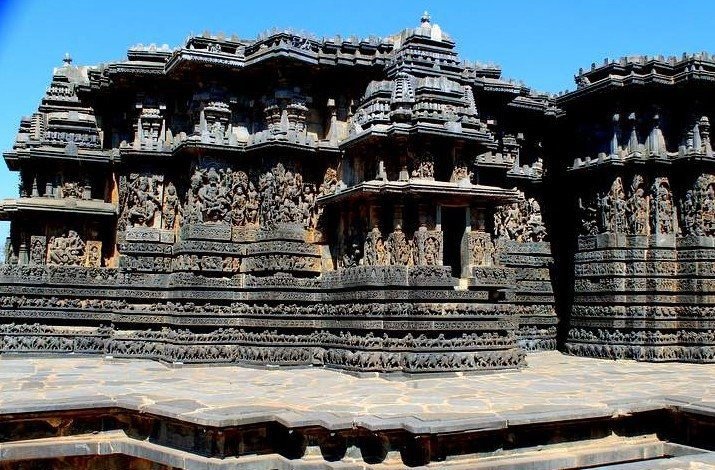Shiva and Parvati at the Nandi bull at the Hoysalesvara temple, Halebidu is a 12th century city located in the Hassan district of Karnataka, India.
The Hoysaleswara Temple, which dates back to 1121 C.E., is astonishing in its wealth of sculptural detail. The walls of the temple are covered with an infinite variety of representations of Hindu mythology, animals, birds and Shilabalikas or dancing figures. However, no two temple sculptures are alike. This magnificent temple guarded by a Nandi bull was never completed, despite 86 years of work. The nearby Jain basadi are equally rich in sculptural detail. Belur and Halebid are 222 and 216 km from Bangalore, respectively. This temple is now proposed as a UNESCO World Heritage Site.
Halebidu is located in Hassan district, Karnataka, India. Halebidu (formerly called Dorasamudra or Dwarasamudra) was the royal capital of the Hoysala Empire in the 12th century. It is home to one of the finest examples of Hoysala architecture in the ornate Hoysaleswara and Kedareswara temples. Halebidu literally means city in ruins. It is given this name because this city was ruined twice by the Bahmani Sultanate.
Halebidu was the capital of the Hoysalas in the 12th century. The Hoysaleswara Temple was built during this time by Ketamala and attributed to Vishnuvardhana, the Hoysala ruler. He consecrates Hoysaleswara and Shantaleswara, named after the temple builder Vishnuvardhana Hoysala and his wife, Queen Shantala.
It was then sacked by the armies of Malik Kafur in the early 14th century, after which it fell into a state of disrepair and neglect.
History
Halebidu is located in the middle of a valley east of the Western Ghats. It is surrounded by low mountains, boulders, and seasonal rivers. This valley is well connected with northern Karnataka, western Andhra Pradesh, and northern Tamil Nadu. Around this region, between the 10th and 14th centuries, the Hoysaḷa dynasty came to power, whose history is not clear. According to their own inscriptions from the 11th and 12th centuries, they were descendants of the Krishna-Baladeva roots and the Yadavas of Maharashtra. They were married in the Hindu Kalyana Chalukya dynasty, known for its temple and artistic tradition. Some historians have questioned the reliability of these inscriptions as a potential mythology on the part of some historians, who propose that the Hoysala were a local Hindu family: a hill chief in the Western Ghats remembered for having killed a tiger or a lion, and they took over and eventually expanded. its power from the 10th century on.
Halebidu was rebuilt near a large reservoir by the early Hoysala kings, with the support of their governors, merchants, and artisans. They excavated and greatly expanded the Dorasamudra reservoir. The important and spectacularly carved Hindu and Jain temples were already completed in the 12th century. Around the city were walls of forts, which generally laid out a rounded square area with an average length of 2.25 kilometers. Inside were four large water tanks and many smaller public water tanks. The life of the city, its main temples and the roads were centered near the Dorasamudra water reservoir. The city has several dozen temples, of which only a small group has survived. Three sets of temples, Hoysaleswara (twin temple), Jain Basadi (3 temples), and Kedareshvara (1 temple), were the largest, most sophisticated in their architecture and artwork, while the rest were simpler.
To the immediate west of the main Hindu and Jain temples was the Hoysala Palace. This palace stretched south to Benne Gudda (literally Butter Hill). The palace is completely ruined and missing, with a section lost in mounds and fragments found near Benne Gudda. To the west of the palace was another group of Hindu and Jain temples: the site of Nagaresvara, also destroyed whose ruins have been found in mounds. To the north of the original city of Hoysala there was a Saraswati temple and a Krishna temple, both also in ruins and mostly lost. Towards the center and south of the old city were the Hucesvara temple and a Rudresvara temple, evidenced by inscriptions and ruins that have been discovered. Four temples have survived in the northeast section: Gudlesvara, Virabhadra, Kumbalesvara, and Ranganatha. The western part of the fortified section and beyond the fort were the historic farms that fed the population of the capital Dorasamudra. The roads connected the capital of Hoysala with other important cities and places of pilgrimage such as Belur and Pushpagiri. Numerous inscriptions dating from the mid-10th to early 13th century attest to the importance of Dorasamudra to various kings of Hoysala.
After the first invasion and destruction of Dorasamudra in the 14th century, the inscriptions suggest that there were attempts to repair the temples, the palace, and the infrastructure at Dorasamudra. As a condition of ending the invasion, Malik Kafur of the Delhi Sultanate demanded that King Ballala accept Khalji’s sovereignty, pay tribute and provide logistical support to the Sultanate forces seeking to raid and loot the legendary wealth in the Pandya capital of Madurai in Tamil. Nadu. Additional waves of wars of destruction and loot from the sultanates ended the kingdom of Hoysala and the prosperity of Dorasamudra as a capital city. For nearly 300 years, Dorasamudra saw no new inscriptions or evidence of political or economic prosperity. A mid-17th century Nayaka-era inscription at Belur thereafter becomes the first to mention “Halebidu.” Meanwhile, the surviving Hindu and Jain communities continued to support and repair the temples, with evidence of living temples in what is now the northern part of Halibidu.


0 Comments